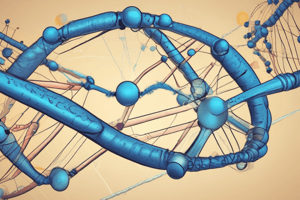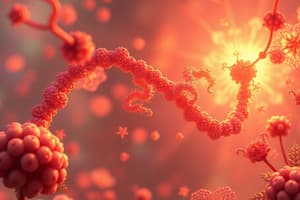Podcast
Questions and Answers
What is the primary function of the PCR technique?
What is the primary function of the PCR technique?
- To amplify DNA millions of fold (correct)
- To synthesize new DNA strands
- To denature DNA strands
- To analyze DNA sequences
What is the temperature required to denature the DNA strands during the PCR process?
What is the temperature required to denature the DNA strands during the PCR process?
- 75°C
- 100°C
- 95°C (correct)
- 55°C
What is the role of oligonucleotide primers in PCR?
What is the role of oligonucleotide primers in PCR?
- To denature the DNA strands
- To synthesize new DNA strands
- To add nucleotides to the DNA template
- To bind to the DNA template (correct)
How many nucleotide bases are typically found in each oligonucleotide primer?
How many nucleotide bases are typically found in each oligonucleotide primer?
What is the direction of nucleotide addition by Taq DNA polymerase?
What is the direction of nucleotide addition by Taq DNA polymerase?
What is the purpose of the final extension step in PCR?
What is the purpose of the final extension step in PCR?
What is the characteristic of Taq DNA polymerase that allows it to correct nucleotide incorporation errors?
What is the characteristic of Taq DNA polymerase that allows it to correct nucleotide incorporation errors?
What is the source of the thermostable DNA polymerases used in PCR?
What is the source of the thermostable DNA polymerases used in PCR?
What is the typical number of cycles performed in a PCR reaction?
What is the typical number of cycles performed in a PCR reaction?
What is the purpose of adding dNTPs to the PCR reaction mixture?
What is the purpose of adding dNTPs to the PCR reaction mixture?
Study Notes
PCR Technique
- PCR (Polymerase Chain Reaction) is a powerful technique used to amplify DNA millions of fold in a short period of time.
- The process utilizes sets of primers, designed based on the DNA sequence to be analyzed.
- Thermostable DNA polymerases (Taq DNA polymerase) are used, isolated from bacteria that grow in thermal vents or hot springs.
- The process involves adding dNTPs (dGTP, dATP, dCTP, and ATP) for building new strands.
Steps of PCR
- Initial step: heating the reaction at 95°C for 1-10 minutes to activate the DNA polymerase and denature the 2 strands (unwinding/separating).
- Consecutive cycles (20-50) are operated, each including three basic steps:
- Denaturation: separating the two strands of DNA at high temperature (95°C) through the destruction of hydrogen bonds (A=T & G≡C).
- Annealing: binding of two oligonucleotide primers (22-30 nucleotide bases each) to their complimentary sequences on the DNA template.
- Extension: Taq DNA polymerase adds complementary dNTPs (based on template DNA sequence) to form new strands in the 5’---3’ direction only.
- Final extension: a single and final step after repetitive cycles (20-50) to ensure all newly amplified fragments are fully elongated with correct base insertion.
Studying That Suits You
Use AI to generate personalized quizzes and flashcards to suit your learning preferences.
Description
This quiz covers the fundamentals of PCR (Polymerase Chain Reaction) technique in molecular biology, including its application in gene therapy and DNA amplification.




